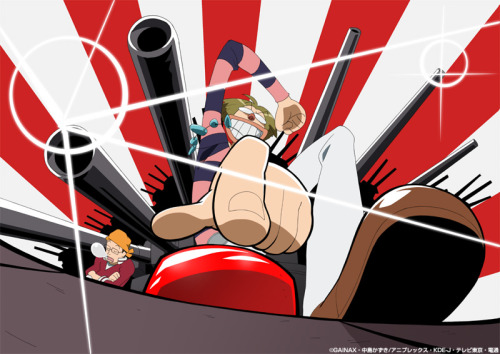
Spelljammer | Guns Ablaze
Ship Combat
Ship combat begins when one or more ships in wildspace become aware of one another, typically when they shift from cruising speed to flying speed as a result of drawing close enough to one another’s gravity fields. Combat typically starts with the combatants at Extreme range from one another, barring other circumstances such as one ship using invisibility to sneak up on another.

Illustrated by Svetlin Velinov
Once combat begins, each combatant rolls initiative, using the side initiative variant presented in page 270 of the Dungeon Master’s Guide. The combatant with the higher result acts first and has initiative, and the combatant with the next highest result acts second, and so on. The combatant with initiative chooses one of its crew members to take their action. After that character takes their action, the corresponding crew member on the other combatant’s ship takes their action, and so on in descending initiative order. After all crew members on each combatant’s ship have taken their actions, a new round starts, and initiative passes from the current holder to the combatant with the next highest initiative check.
Example:
Ship A and Ship B are engaged in ship combat. Ship A wins the initiative check, and has initiative. The flow of combat is as follows:
- Ship A Captain -> Ship B Captain
- Ship A Spelljammer -> Ship B Spelljammer
- Ship A Quartermaster-> Ship B Quartermaster
- Ship A Gunner -> Ship B Gunner
- Ship A Bosun -> Ship B Bosun
- Round 1 of combat ends, initiative passes from Ship A to Ship B
- Ship B Spelljammer - > Ship A Spelljammer
- Ship B Quartermaster-> Ship A Quartermaster
- Ship B Captain -> Ship A Captain
- Ship B Gunner- > Ship A Gunner
- Ship B Bosun -> Ship A Bosun
- Round 2 of combat ends, initiative passes from Ship B to Ship A
A ship combat encounter ends when 1) one ship is reduced to 0 hit points, 2) one ship Flees from the other at Extreme range, exiting the encounter, 3) crew from one ship board the other, moving from ship combat into a regular combat encounter.
More Dakka
At this point, we’ve covered the ship’s movement (Captain) and its advanced technology capabilities (Spelljammer), but there’s still one critical role that hasn’t been developed yet - the Gunner. After all, a fundamental aspect of ship combat is the vessels exchanging volleys of weapons fire. Technically, the existing rules already account for this, with siege weapons such as ballistae and mangonels being standard fixtures on most spelljamming ships, along with the crew to operate them. So where does the Gunner come into it?
The Spelljammer Academy adventures set out three simple roles that characters can take aboard a spelljamming ship - Captain, Spelljammer, and Shipmate. The Shipmate role is the one involved in operating shipboard weapons, which presumably also involves being the one to fire the weapon and make the attack roll, notwithstanding that shipboard weapons already have their own fixed attack bonuses. NPC crew members (“crewmates”) help out with loading and aiming, ensuring that these unwieldy siege weapons can be fired every round, but by and large they are background fixtures, passively facilitating what the characters are doing.
By abstracting all the actions needed to load, aim, and fire shipboard weapons into the role of the Gunner, the ‘firing phase’ of ship combat becomes synonymous with the Gunner’s turn. There are two images that resonate with the Gunner’s role here: firstly, that of an artillery officer signalling their soldiers to launch a coordinated barrage, secondly, that of Beamspam McMuppet.

A supporting character from Gurenn Lagann, Attenborough Cortitch (better known by some fans as Beamspam McMuppet) is a stowaway who becomes the crew’s de facto gunner by doing one thing and one thing only: firing the weapons. All of them, at the same time, with no signal whatsoever. Spelljammer shipboard weapons haven’t gotten to the point that they can all be fired with the press of a single button, but if they could be, you can bet that he’d be spamming it (jamming it, if you will). Hardly sophisticated or professional, but say what you will about Beamspam McMuppet - you always knew what he was going to do and what was going to happen once he did it.
On Bonuses and Firing

Illustrated by Chris Rallis
The GGW Rules, another take on 5e Spelljammer ship combat that I draw inspiration from, also sets out a Gunner role, which casts player characters as individual gunners, each one firing their own shipboard weapon. I departed from this approach in favor of a more abstract role that puts the Gunner in a leadership position over crewmates, who are the ones using their actions to load, aim, and fire the weapons. This meshes better with the roster of crew roles I have established, where each player character assumes command of a particular aspect of the ship’s functioning.
The GGW Rules explicitly noted that although shipboard weapons have fixed bonuses to hit as set out by the Dungeon Master’s Guide, it recommends using the player character’s ranged weapon attack bonus instead, so that shipboard weapon attack rolls will scale with the player characters’ levels. In the context of player characters acting as individual gunners, this approach makes sense, as it reflects the growing skill of the character. However, my system focuses less on the Gunner’s physical capability to aim and fire a weapon than their tactical acumen in deploying their ship’s weapons. Furthermore, the official 5e Spelljammer material already spells out the fixed bonuses to hit of shipboard weapons, as well as the established ACs of ship hulls and shipboard weapons, and I aim to stay within these parameters as far as possible.
But are the existing parameters suitable for fun, engaging ship combat? Let’s take a look at how these numbers work out in practice. The average AC of the ships presented in the Astral Adventurer’s Guide is 16.25, and the average fixed attack bonus of the most common shipboard weapons (ballista, cannon, mangonel) is +5.7. On average, a Gunner must roll at least an 11 on the d20 for an attack roll on a ship’s hull to hit, which is a 50% chance of success. The average damage of these weapons is 29, the average number of weapons mounted on each ship is 3, and the average HP of a ship is 300. With some fudgy maths, this works out to a Gunner having to make 21 attacks with shipboard weapons on average to reduce an enemy ship’s hull to 0 HP, which will take about 7 rounds.

What 7 rounds of combat does to a player
Most regular combat encounters in D&D don’t last 7 rounds, and those that do would be considered draggy - players’ attention spans, energy level, and investment in the encounter tend to wane after 3 rounds, let alone 7. Of course, this doesn’t take into account other possible outcomes from a ship combat encounter besides one ship reducing the other to 0 HP - ramming and boarding, or escaping, are also options. This is perhaps why some players and DMs have reported that ship combat as it currently stands is draggy and boring, and prefer to proceed to boarding.
However, my goal here is for ship combat to be fun when played straight, and one clear improvement would be to tighten the pacing by lowering the number of rounds required to destroy an enemy ship. This can be done by raising the accuracy of shipboard weapons, or increasing their damage output. But wait, isn’t this the exact opposite of staying within the established parameters? Not exactly - I am using the baseline numbers as a foundation to build new mechanics on, similar to how class and subclass features build on the basic numbers of weapons and armor. The Captain’s piloting maneuvers are built on the concept of the Fighter Battlemaster’s maneuvers, for example, and can speed combat up by increasing damage and accuracy. Additionally, the Spelljammer can contribute to the ship’s damage output via spells such as Phlogiston Blast, further speeding combat up. Granted, defensive options also exist for the Captain and Spelljammer, and we haven’t even gotten to the Bosun yet. But making it possible to achieve victory in fewer rounds raises the stakes of each round of ship combat and keeps the tension high, creating a more engaging play experience.
Taking Aim

Illustrated by Justyna Gil
On the Gunner’s turn, they take command of all crewmates responsible for manning the shipboard weapons. All such crewmates act on the Gunner’s mark, and all their actions are resolved during the Gunner’s turn, with any attack rolls being made by the Gunner. Sounds good, but what is there for the Gunner to do aside from roll a bunch of dice? Not that rolling attack and damage rolls isn’t fun in and of itself, but combat would get rather monotonous for the Gunner if all they’re doing is repeatedly ordering all weapons to fire on the enemy ship.
Well, consider the other actions involved in operating the shipboard weapons - loading and aiming. Besides the obvious target of the enemy ship’s hull, are there other targets that the Gunner might want to take aim at? Back in my Sea of Thieves days, a common tactic in ship combat was to aim for certain critical parts of the enemy ship - the mast, to cripple their movement, the capstan, to prevent them from dropping anchor and making sharp turns, or even specific crew members on deck such as the captain.
Spelljammer 5e has simplified how spelljamming ships work to a large degree - there are no sails or anchors to worry about, for example. However, that’s not to say that there can’t be key targets on a ship beyond the hull. One obvious target is the enemy ship’s shipboard weapons - siege weapons have AC and HP baked in, so it was clearly envisioned that they could be disabled by damaging them. Crippling an enemy ship’s offensive capabilities is one strategy that a Gunner might favor.
Crew Casualties

Illustrated by Ben Wootten
Of course, aiming for crew members on deck is also an option. Here we come to another new mechanic - crewmates as a resource. Ghosts of Saltmarsh had mechanics that tied the number of crewmates aboard a ship to the actions it could take, and I wanted to integrate some element of this into my version of ship combat. As mentioned above, crewmates are passive facilitators for the characters’ actions - up until the point that they’re taken out of action. In Ghosts of Saltmarsh, crewmates were needed for manning the sails, rigging, and such, in addition to shipboard weapons - this is not the case in wildspace, where movement is largely handled by the Captain and Spelljammer. The only role that crewmates seem to have here is to operate shipboard weapons, which is an offensive function. To add some depth here, I am expanding crewmate responsibilities to conducting repairs on the ship, which falls under the Bosun’s purview. The Bosun, in my ship combat system, is the counterpart to the Gunner, a defensive role that conducts and coordinates repairs to the ship - but that’s another post.
Coming back to the Gunner, we see a few targeting options on the enemy ship: 1) the hull, 2) the shipboard weapons, or 3) the crewmates. Aiming at the hull and the shipboard weapons is straightforward - these have their own AC and HP, but some abstraction is required to figure out how a shipboard weapon interacts with crewmates who will, by default, use the commoner statblock. 10 AC and 4 hit points don’t stack up well against ballistae and mangonels, to say nothing of higher-calibre shipboard weapons.
Here, I would abstract the consequences of shipboard weapons hitting crewmates - instead of a ballista bolt or mangonel stone directly striking a crewmate (and reducing them to paste), firing on crewmates is construed as artillery fire that does only superficial damage to a ship’s hull, but wreaks havoc on exposed personnel due to its impact. To target crewmates, the Gunner makes an attack roll against the ship’s hull AC as normal. On a hit, the Gunner rolls damage for that weapon, but instead of damaging the hull, for every 5 damage (rounded down), that many crewmembers on the enemy ship are wounded. Wounded crewmates are alive, but unable to contribute to the operation of the ship until they recover. As with maneuverability penalties based on vessel size, this formula needs some playtesting to check balance, but it serves as a proof of concept.
Locked and Loaded

Illustrated by Zezhou Chen
With firing and aiming covered, we now move to loading. All siege weapons have a default ammunition option listed in their statblock, but certain weapons such as the mangonel and trebuchet explicitly note that other types of projectiles could be fired from them. Special ammo - explosive shells, incendiary rounds, and such - are fixtures in any game that involves shooting projectiles, and Spelljammer is no exception. Such special ammo will be built on existing siege projectiles (ballistae bolts, mangonel stones), so that it is clear which weapon it is meant to be fired from. Let’s consider a few examples:
Piecemaker Cluster
This thick bundle of longbow arrows is designed to be fired from a ballista and disperse midflight, trading raw stopping power for increased effectiveness against personnel.
Ballista Bolt. Ranged Weapon Attack: +6 to hit, range 120/480 ft., one target. Hit: 11 (2d10) piercing damage.
Special. The Piecemaker Cluster’s cloud of arrows is particularly devastating against crewmates. When used to target crewmembers, this projectile wounds twice as many crewmates as a regular ballista bolt.
Sticky Bomb
This specially-weighted barrel holds a payload of sovereign glue, guaranteed to gum up the works of anything it hits.
Mangonel Stone. Ranged Weapon Attack: +5 to hit, range 200/800 ft. (can’t hit targets within 60 feet of it), one target. Hit: 22 (4d10) bludgeoning damage.
Special. When used to target shipboard weapons, a single hit from a Sticky Bomb automatically disables a weapon regardless of its hit points.
Ball of Burden
This rune-etched blue-steel cannonball feels even heavier than its bulk would suggest, making it unwieldy to fire.
Cannon Ball. Ranged Weapon Attack: +6 to hit, range 600/2400 ft., one target. Hit: 32 (6d10) bludgeoning damage.
Special. When this projectile hits the hull of a ship, its unnatural weight temporarily transfers to the ship, making it harder to maneuver. The next Pilot check made for that ship within the next round is made at disadvantage.
Besides deciding how to deploy special ammo, the Gunner should also be in charge of managing regular ammunition - spelljamming ships have limited cargo space, and can only hold so many bolts, stones, or cannonballs, after all. This also extends to crewmembers - as casualties start to mount, the Gunner must call in reserves and decide how to reassign crewmembers to weapons.
Recap
To quickly recap, on the Gunner’s turn, they make the following decisions:
- How to deploy crewmates to each shipboard weapon;
- What ammo to load on each shipboard weapon;
- Which target to aim each shipboard weapon at;
- The order in which each shipboard weapon is fired.
The Gunner does not have to declare all their decisions simultaneously, and can load, aim, and fire one weapon before deciding how to deploy other weapons. Each shipboard weapon can only be fired once at most during the Gunner’s turn, and any crewmates that have already used their action to assist in loading, aiming, or firing a weapon cannot take further actions.
